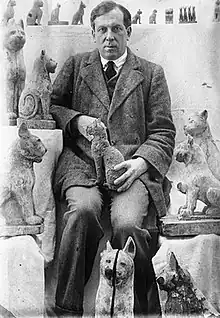Cecil Mallaby Firth (5 July 1878[1] – 1931) was a British Egyptologist.

Firth was baptised at Ashburton in Devon on 14 August 1878, the son of Henry Mallaby Firth, gent., and Frances (Fanny) Caunter.[2][3] He became a lawyer, and after briefly working in Cyprus left to join the Service des Antiquités in Egypt, an organisation run by French scholars to prevent the illicit trade in Egyptian artifacts.[4] Firth worked on the first archaeological survey of Nubia of 1907 to 1911. In 1912 he set up the Aswan Museum.[5] He became the inspector of antiquities at Saqqara and began to explore the complex of Djoser's Step Pyramid in Saqqara where, in 1924, he discovered the serdab of the pharaoh, which is now in the Egyptian Museum in Cairo.[5]
Firth then worked in collaboration with James E. Quibell and subsequently with Jean-Philippe Lauer on his arrival on the site in 1926.[6]
In 1928 and 1929, Firth began the opening of the funerary complex of Userkaf, the first king of the 5th dynasty, and that of a small pyramid located just at the south, allotted to his queen.[7] In early 1930 he worked on the Headless Pyramid, believing it to be a pyramid of a king of the First Intermediate Period. It is now understood that the pyramid belongs to Menkauhor Kaiu of the Fifth Dynasty.
Firth's wife was Winifred (Freda) Nest Firth (née Hansard, 1871–1937), a painter and copyist.[8]
Death
In 1931 Firth worked on clearance of the archaic tombs of Saqqara but contracted pneumonia whilst on leave in England, resulting in his untimely death.
Selected publications
- The archæological survey of Nubia. Report for 1907-1908. 1910.
- The archaeological survey of Nubia : report for 1908-1909. 1912.[9]
- The archaeological survey of Nubia. Report for 1909-1910. 1915.
- with Battiscombe Gunn: Excavations at Saqqara; Teti pyramid cemeteries. 1926.
References
- ↑ Sir Bernard Burke, C.B., LL.D. (1882). A Genealogical and Heraldic History of the Landed Gentry of Great Britain & Ireland. Vol. II. Harrison, Pall Mall. p. 1784.
{{cite book}}: CS1 maint: multiple names: authors list (link) - ↑ "Old Ashburton: The Firth Family". Retrieved 12 November 2020.
- ↑ F. Lyde Caunter (1957). Under the Surface. H.E. Warne.
- ↑ "sca". Archived from the original on 17 October 2016. Retrieved 1 August 2015.
- 1 2 Cecil Mallaby Firth; Battiscombe George Gunn (1 June 2007). Excavations at Saqqara: Teti Pyramid Cemeteries. Martino Pub. ISBN 978-1-57898-651-4.
- ↑ Metropolitan Museum of Art (New York, N.Y.) (1 January 1999). Egyptian Art in the Age of the Pyramids. Metropolitan Museum of Art. pp. 135–. ISBN 978-0-87099-907-9.
- ↑ Abeer El-Shahawy; Farid S. Atiya (2005). The Egyptian Museum in Cairo. American Univ in Cairo Press. pp. 75–. ISBN 978-977-17-2183-3.
- ↑ ArtUK
- ↑ "Review of The Archeological Survey of Nubia: Report for 1908–1909 by C. M. Firth". The Athenaeum (4473): 67. 19 July 1913.